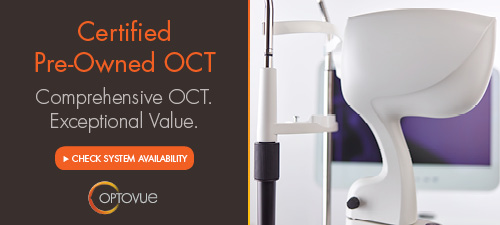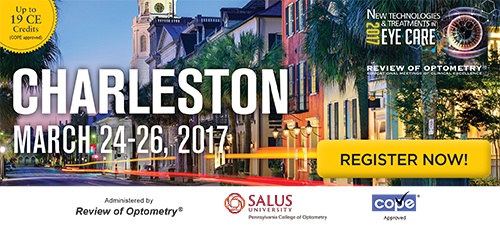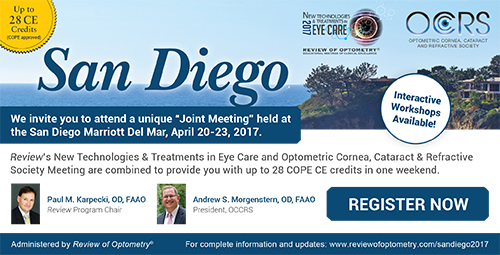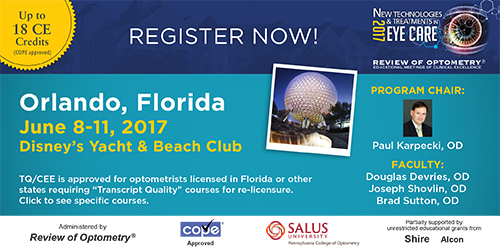
A
weekly e-journal by Art Epstein, OD, FAAO
Off the Cuff: An Open Letter
Dear President Trump: I know health care reform is at the top of your agenda for change. As health care providers we share your concern about our broken system and even more about the wellbeing of our patients. America once had the greatest health care in the world, and we, like you, want to restore the system to its former greatness. We are in the trenches, and we see the problems first hand—every day. Health care providers are being strained to their very limits. Heath insurers are out of control. They continue to make caring for our patients increasingly difficult. Prescribing a new medication that’s best for a patient has become punishing because of intentional roadblocks and being forced to jump through wearying hoops. We’re paid for our services at rates that are often at the very edge of sustainability and have to fight for every cent, devoting staff time and resources that should be used to care for our patients. Health insurance was broken long before Obamacare existed. If you are truly going to fix health care in our country, health insurance needs to be fixed first. Likewise, federal and state bureaucracies are slowly draining the lifeblood of our practices. Feel-good regulations are strangling both innovation and education. Today, drug companies have more lawyers on staff than doctors and scientists. For doctors, an endless stream of stupid acronyms forces box checking in order to meet meaningless quality of care requirements. We spend our days staring at computers with our backs to our patients. Mr. President, quality care requires looking in a patient’s eyes, taking the time to listen and actually caring about them. We hate what health care has become.
|
|||||
|
|||
| Neovascular Glaucoma After Vitrectomy in Proliferative Diabetic Retinopathy | ||||
The aim of this study was to evaluate the prevalence and risk factors of neovascular glaucoma (NVG) after vitrectomy in patients with vitreous hemorrhage associated with proliferative diabetic retinopathy (PDR). This retrospective, noncomparative, observational study included 127 eyes of 127 patients with PDR who received vitrectomy with a follow-up period of at least 6 months. The prevalence of NVG and associated risk factors were assessed, including sex, age, previous panretinal photocoagulation, baseline intraocular pressure, combined phacovitrectomy and pretreatment with intravitreal bevacizumab (IVB) before vitrectomy for the treatment of vitreous hemorrhage.
NVG developed in 15 (11.8%) of 127 patients. Of the 15 eyes with NVG, 11 cases (73.3%) postoperatively developed NVG within six months. Postoperative NVG was associated with preoperative IVB treatment. The prevalence of NVG after vitrectomy was 11.8%, and an associated risk factor for NVG was preoperative IVB for the treatment of vitreous hemorrhage. |
||||
SOURCE: Kwon JW, Jee D, La TY. Neovascular glaucoma after vitrectomy in patients with proliferative diabetic retinopathy. Medicine (Baltimore). 2017;96(10):e6263. |
||||
 |
||
| Targeting Oxidative Stress for Treatment of Glaucoma and Optic Neuritis | ||||
Glaucoma is a neurodegenerative disease of the eye and is one of the leading causes of blindness. In addition, the disease—characterized by progressive degeneration of retinal ganglion cells (RGCs) and their axons as part of the optic nerve—is usually associated with elevated intraocular pressure (IOP). Current glaucoma therapies target reduction of IOP, but since RGC death is the cause of irreversible vision loss, neuroprotection may be an effective strategy for glaucoma treatment, researchers wrote. One of the risk factors for glaucoma is increased oxidative stress, and drugs with antioxidative properties such as valproic acid and spermidine, as well as the ability to inhibit apoptosis signal-regulating kinase 1—an enzyme that is involved in oxidative stress—have been reported to prevent glaucomatous retinal degeneration in mouse models of glaucoma. Optic neuritis is a demyelinating inflammation of the optic nerve that presents with visual impairment, and it is commonly associated with multiple sclerosis— a chronic demyelinating disease of the central nervous system. Researchers wrote that, although steroids are commonly used for treatment of optic neuritis, reduction of oxidative stress by approaches such as gene therapy can be effective in ameliorating optic nerve demyelination in preclinical studies. |
||||
SOURCE: Kimura A, Namekata K, Guo X, et al. Targeting oxidative stress for treatment of glaucoma and optic neuritis. Oxid Med Cell Longev. 2017;2017:2817252 |
||||
|
|||
| Effect of Smoking on Thickness of Retinal Layers in Healthy Smokers | ||||
A total of 108 subjects were included in this study to compare the thicknesses of the retinal layers in smokers with those of non-smoking healthy subjects, using spectral-domain optical coherence tomography (SD-OCT). Two groups were separated as smokers and non-smokers. Both groups were chosen to be similar in terms of age and gender. SD-OCT images were generated with Spectralis OCT (Heidelberg Engineering). An automated algorithm was developed to segment the macular retina into eight layers and quantitate the thickness of each layer for the fovea, parafovea and perifovea. The mean smoking history was 18.33 years ± 8.45 years (range: 10 to 40). The mean number of pack-years was 22.22 ± 15.51 (range: 10 to 80). No significant difference was observed regarding retinal layer measurements between the smoker and nonsmoker groups. Also, no significant difference was observed for central macular thicknesses at 1,000μm, 3,000μm and 6,000μm between the two groups. The thickness of retinal layers in healthy smokers were similar to those of healthy individuals. |
||||
SOURCE: Duman R, Duman R, Sabaner MC, et al. Effect of smoking on the thickness of retinal layers in healthy smokers. Cutan Ocul Toxicol. 2017;3:1-8. |
||||
 |
||
| News & Notes | |||||||||
| Alcon Launches Programs to Improve Access to Affordable Contact Lens Wear Alcon’s new Air Optix Choice program is designed to provide patients access to the latest technology in monthly contact lenses and an easy-to-remember replacement schedule. It offers significant savings on most Air Optix contact lenses, including new Air Optix plus HydraGlyde contact lenses. At the same time, Alcon will extend its existing Dailies Choice program, which allows eye care professionals to offer patients access to a convenient and compliant contact lens option by reducing the price of Dailies brand lenses to that of two-week replacement lenses. Read more. |
|||||||||
| Allegro Ophthalmics Names Sarayba VP of Clinical Affairs Allegro Ophthalmics announced that Melvin Sarayba, MD, joined the company as vice president of clinical affairs. Dr. Sarayba is responsible for Allegro's U.S. and international clinical program for Luminate, which met its primary and secondary endpoints in the DEL MAR Phase IIb clinical trial for diabetic macular edema, announced in October 2016. An ophthalmic surgeon with an extensive clinical research background and two decades of product development and commercialization experience, Dr. Sarayba has worked for multiple ophthalmic companies, including IntraLase, AMO, WaveTec, LenSx Lasers, Alcon Laboratories and ClarVista Medical. Read more. |
|||||||||
|
Optometric Physician™ (OP) newsletter is owned and published by Dr. Arthur Epstein. It is distributed by the Review Group, a Division of Jobson Medical Information LLC (JMI), 11 Campus Boulevard, Newtown Square, PA 19073. HOW TO ADVERTISE |






